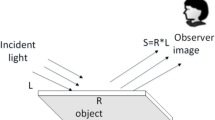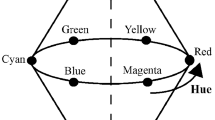Abstract
In order to improve the brightness and contrast of low illumination color images and avoid over enhancement, an adaptive image enhancement algorithm based on visual saliency is proposed. Firstly, the original low illumination image is transformed from Red Green Blue (RGB) color space to Hue Saturation Intensity (HSI) color space. Secondly, the bilateral gamma adjustment (BIGA) function combined with the cuckoo search algorithm is used for adaptively increasing the overall brightness of image. In addition, the brightness preserving Bi-histogram construction based on visual salience algorithm (BBHCVS) is proposed to respectively conserve the brightness and improve the contrast of low illuminance color images. Finally, the processed HSI color space is transformed into RGB color space to get the enhanced image. Experimental results demonstrate that the proposed BBHCVS algorithm can effectively enhance the visual salient areas of human perception, and also significantly improve the contrast and brightness of image compared with other well-known and state-of-the-art methods.


















Similar content being viewed by others
References
Bianco S, Cusano C, Piccoli F, Schettini R (2020) Personalized image enhancement using neural spline color transforms. IEEE Trans Image Process 29:6223–6236
Yamakawa M, Sugita Y (2018) Image enhancement using Retinex and image fusion techniques. Electronics and Communications in Japan 101(8):52–63
Aamir M, Rehman Z, Pu YF, Ahmed A, Abro WA (2019) Image enhancement in varying light conditions based on wavelet transform. In: 2019 16th international computer conference on wavelet active media technology and information processing, Chengdu, China, December 2019. IEEE, pp 317-322
Chen SD, Ramli AR (2004) Minimum mean brightness error bi-histogram equalization in contrast enhancement. IEEE Trans Consum Electron 49(4):1310–1319
Land EH (1977) The Retinex theory of color vision. Sci Am 237(6):108–128
Jobson DJ, Rahman ZU, Woodell GA (1997) Properties and performance of a center/surround Retinex. IEEE Trans Image Process 6(3):451–462
Rahman Z, Jobson DJ, Woodell GA (1996) Multiscale retinex for color image enhancement. In: proceedings of 3rd IEEE international conference on image processing, Lausanne, Switzerland, September 1996. IEEE, pp 1003-1006
Jobson DJ, Rahman Z, Woodell GA (2002) A multiscale retinex for bridging the gap between color images and the human observation of scenes. IEEE Trans Image Process 6(7):965–976
Panetta K, Gao C, Agaian S (2013) No reference color image contrast and quality measures. IEEE Trans Consum Electron 59(3):643–651
Wang S, Zheng J, Hu HM, Li B (2013) Naturalness preserved enhancement algorithm for non-uniform illumination images. IEEE Transactions on Image Processing A Publication of the IEEE Signal Processing Society 22(9):3538–3548
Guo X, Li Y, Ling H (2017) LIME: low-light image enhancement via illumination map estimation. IEEE Trans Image Process 26(2):982–993
Wang W, Chen Z, Yuan X, Wu X (2019) Adaptive image enhancement method for correcting low-illumination images. Inf Sci 496:25–41
Huang SC, Cheng FC, Chiu YS (2013) Efficient contrast enhancement using adaptive gamma correction with weighting distribution. IEEE Transactions on Image Processing A Publication of the IEEE Signal Processing Society 22(3):1032–1041
Al-Ameen Z (2019) Nighttime image enhancement using a new illumination boost algorithm. IET Image Process 13(8):1314–1320
Hummel R (1977) Image enhancement by histogram transformation. Computer Graphics and Image Processing 6(2):184–195
Ueda Y, Suetake N (2019) Hue-preserving color image enhancement on a vector space of convex combination coefficients. In: 2019 IEEE international conference on image processing (ICIP), Taipei, Taiwan, September 2019. IEEE, pp 939-943
Zuiderveld K (1994) Contrast limited adaptive histogram equalization. Graphics Gems 1994:474–485
Ibrahim H, Kong NSP (2007) Brightness preserving dynamic histogram equalization for image contrast enhancement. IEEE Trans Consum Electron 53(4):1752–1758
Kim YT (1997) Contrast enhancement using brightness preserving bi-histogram equalization. IEEE Trans Consum Electron 43(1):1–8
Jung C, Sun T (2017) Optimized perceptual tone mapping for contrast enhancement of images. IEEE Transactions on Circuits and Systems for Video Technology 27(6):1161–1170
Sim KS, Tso CP, Tan YY (2007) Recursive sub-image histogram equalization applied to gray scale images. Pattern Recogn Lett 28(10):1209–1221
Gupta B, Agarwal TK (2017) Linearly Quantile separated weighted dynamic histogram equalization for contrast enhancement. Comput Electr Eng 62:360–374
Kansal S, Tripathi RK (2020) Adaptive geometric filtering based on average brightness of the image and discrete cosine transform coefficient adjustment for gray and color image enhancement. Arab J Sci Eng 45(3):1655–1668
Deng Z, Peng X, Li Z, Qiao Y (2019) Mutual component convolutional neural networks for heterogeneous face recognition. IEEE Trans Image Process 28(6):3102–3114
Malhotra P, Kumar D (2019) An optimized face recognition system using cuckoo search. J Intell Syst 28(2):21–332
Rupak C, Rama S, Garg ML (2019) An improved PSO-based multilevel image segmentation technique using minimum cross-entropy Thresholding. Arab J Sci Eng 44(4):3005–3020
Karimi D, Salcudean SE (2020) Reducing the Hausdorff distance in medical image segmentation with convolutional neural networks. IEEE Trans Med Imaging 39(2):499–513
Oktay O, Ferrante E, Kamnitsas K, Heinrich M, Bai WJ, Caballero J, Cook SA, Marvao AD, Dawes T, Regan DPO, Kainz B, Glocker B, Rueckert D (2018) Anatomically constrained neural networks (ACNNs): application to cardiac image enhancement and segmentation. IEEE Trans Med Imaging 37(2):384–395
Nickfarjam AM, Ebrahimpour-Komleh H (2017) Multi-resolution gray-level image enhancement using particle swarm optimization. Appl Intell 47:1132–1143
Kanmani M, Narasimhan V (2018) Swarm intelligent based contrast enhancement algorithm with improved visual perception for color images. Multimed Tools Appl 77(10):12701–12724
Li C, Liu J, Wu Q, Bi L (2020) An adaptive enhancement method for low illumination color images. Appl Intell 51:202–222. https://doi.org/10.1007/s10489-020-01792-3
Ramík DM, Sabourin C, Moreno R, Madani K (2014) A machine learning based intelligent vision system for autonomous object detection and recognition. Appl Intell 40(2):358–375
Li N, Bi H, Guan H, Li Y (2020) Optimization algorithm on salient detection. Multimed Tools Appl 79:6437–6445
Itti L, Koch C, Niebur E (2002) A model of saliency-based visual attention for rapid scene analysis. IEEE Trans Pattern Anal Mach Intell 20(11):1254–1259
Achanta R, Estrada F, Wils P, Süsstrunk S (2008) Salient region detection and segmentation. In: 6th international conference on computer vision systems, Berlin Heidelberg, may 2008. Springer Verlag, pp 66-75
Harel J, Koch C, Perona P (2006) Graph-based visual saliency. Proceedings of the Twentieth Annual Conference on Neural Information Processing Systems, Vancouver, British Columbia, Canada, December 2006:545–552
Yang XS, Deb S (2009) Cuckoo search via levy flights. In: 2009 world congress on nature and biologically inspired computing (NaBIC), Coimbatore, India, December 2009. IEEE, pp 210-214
Viswanathan GM, Afanasyev V, Buldyrev SV, Havlin S, Stanley HE (2000) Levy flights in random searches. Physica A Statal Mechanics and Its Applications 282(1–2):1–12
Huang Z, Zhao J, Qi L, Gao ZZ, Duan H (2020) Comprehensive learning cuckoo search with chaos-lambda method for solving economic dispatch problems. Appl Intell 50:2779–2799
Zhi N, Mao SJ, Li M (2018) An enhancement algorithm for coal mine low illumination images based on bi-gamma function. Journal of Liaoning Technical University (Natural Science Edition) 37(1):191–197
Song RX, Li D, Yu JD (2018) Low illumination image enhancement algorithm based on DT-CWT and tone mapping. Journal of Computer-Aided Design and Computer Graphics 30(7):131–138
Wang DW, Han PF, Fan JL, Liu Y, Xu ZJ, Wang J (2018) Multispectral image enhancement based on illuminance-reflection imaging model and morphology operation. Acta Phys Sin 67(21):88–98
Bychkovsky V, Paris S, Chan E, Durand F (2011) Learning photographic global tonal adjustment with a database of input/output image pairs. In: proceedings of the IEEE computer society conference on computer vision and pattern recognition (CVPR), Providence, RI, USA, June 2011. IEEE, pp 97-104
Saxena N, Mishra KK (2017) Improved multi-objective particle swarm optimization algorithm for optimizing watermark strength in color image watermarking. Appl Intell 47:362–381
Wan MJ, Gu GH, Wian WX, Kan R, Qian C, Xavier M (2018) Infrared image enhancement using adaptive histogram partition and brightness correction. Remote Sens 10(5):682
Snchez-Peralta LF, Picn A, Snchez-Margallo FM, Pagador JB (2020) Unravelling the effect of data augmentation transformations in polyp segmentation. Int J Comput Assist Radiol Surg 15(12):1975–1988
Ronneberger O, Fischer P, Brox T (2015) U-net: convolutional networks for biomedical image segmentation. International conference on medical image computing and computer-assisted intervention, Cham, Germany, October 2015. Springer, pp 234-241
Ye ZW, Wang FW, Kochan R (2020) Image enhancement based on whale optimization algorithm. In: 15th international conference on advanced trends in Radioelectronics, telecommunications and computer engineering (TCSET), Lviv-Slavske, Ukraine, February 2020. IEEE, pp 838-841
Dhason HGCA, Muthaia I, Sakthivel SP, Shanmugam S (2020) Super-resolution mapping of hyperspectral satellite images using hybrid genetic algorithm. IET Image Process 14(7):1281–1290
Rajput SS, Bohat VK, Arya KV (2019) Grey wolf optimization algorithm for facial image super-resolution. Appl Intell 49(4):1324–1338
Ozturk S, Ahmad R, Akhtar N (2020) Variants of artificial bee colony algorithm and its applications in medical image processing. Appl Soft Comput 97:106799
Kamoona AM, Patra JC (2019) A novel enhanced cuckoo search algorithm for contrast enhancement of gray scale images. Appl Soft Comput 85:105749
Aw A, Mkn A, Rp B, Bj C, Aa D (2020) A differential evolutionary adaptive Harris hawks optimization for two dimensional practical masi entropy-based multilevel image thresholding. Journal of King Saud University - Computer and Information Sciences. https://doi.org/10.1016/j.jksuci.2020.05.001
Ono S, MaeDa H, Sakimoto K, Nakayama S (2014) User-system cooperative evolutionary computation for both quantitative and qualitative objective optimization in image processing filter design. Appl Soft Comput 15:203–218
Coelho L, Sauer JG, Rudek M (2009) Differential evolution optimization combined with chaotic sequences for image contrast enhancement. Chaos Solitons and Fractals 42(1):522–529
Chatterjee A, Siarry P (2014) Advances in evolutionary optimization based image processing. Eng Appl Artif Intell 31:1–2
Reynosa-Guerrero J, Garcia-Huerta JM, Vazquez-Cervantes A, Reyes-Santos E, Jimenez-Hernandez H (2021) Estimation of disparity maps through an evolutionary algorithm and global image features as descriptors. Expert Syst Appl 165:113900
Acknowledgements
This research is financially supported by National Natural Science Foundation of China under Grant 61672470, and The key scientific research projects of universities in Henan province under Grant 20A520004, and the Youth core teacher training program of universities in Henan province under Grant 2019GGJS138.
Author information
Authors and Affiliations
Corresponding author
Additional information
Publisher’s note
Springer Nature remains neutral with regard to jurisdictional claims in published maps and institutional affiliations.
Rights and permissions
About this article
Cite this article
Qian, S., Shi, Y., Wu, H. et al. An adaptive enhancement algorithm based on visual saliency for low illumination images. Appl Intell 52, 1770–1792 (2022). https://doi.org/10.1007/s10489-021-02466-4
Accepted:
Published:
Issue Date:
DOI: https://doi.org/10.1007/s10489-021-02466-4




